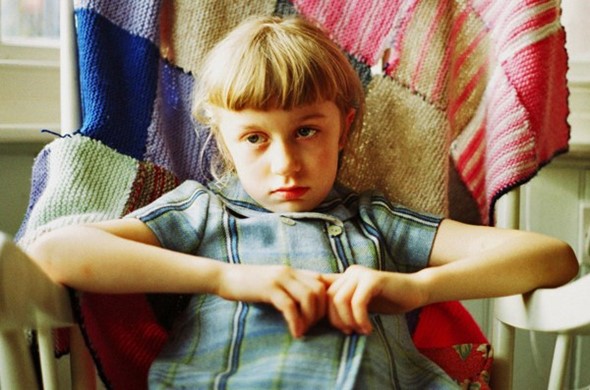
Still from »Everything That Rises Must Converge«, 2010
Images from Life
MARGARET SALMON’s films disclose their subjects by intimation; her characters emerge by degrees, by the slightest of gestures. A darting glance into the camera, wiping moisture from a hot brow, cradling the butt of a rifle: this is a slow cinema, marked less by ruptures and revolution than by Salmon’s proximal relation to intimate bodies. By ISLA LEAVER-YAP
Often working with a biographical constellation of subjects – family, friends, or local figures sourced from Salmon’s hometowns in suburban New York and Whitstable, England – intimacy is the sustained register of her films. Her work articulates »the emotive connection between humans,« which, says the artist, »can be transformed and described through film.« Salmon, born in New York in 1975, usually shoots her films alone, without artificial lighting, cinematographer, or sound engineer, and her work has frequently been described in relation to the documentary genre and cinéma vérité. But if the documentary is, as Cahiers du cinéma’s film critic Jean-Louis Comolli would have it, a creative attack on the ensemble of narratives unsuited to the cinematic, then Salmon’s form and its attendant narratives find themselves manifesting within the margins of the documentary and cinematic image. Her work searches for some through-road that attempts to reinvest the everyday with the lyrical nature of routine and, within those routines, she allows the camera to record rarer, incidental moments that emerge from breaks in habitual activity: the minor fissures where an alternative psychology manifests in opposition to one’s predetermined archetype, and where the masks of her performing subjects slip.
One of Salmon’s early films, PS (2002), is illustrative of the artist’s selective approach to documentary and cinema. A painfully slow unpicking of a marriage, PS is set against a backdrop of pastoral images and sun-bleached suburbia. Salmon’s camera follows an ageing male protagonist who sluggishly goes about his daily routine. His actions are accompanied by a separately recorded soundtrack that comprises a bitter domestic argument between an elderly couple in which the husband’s voice is implicitly tied to the voice of the man presented on-screen. Voices torpidly accuse one another: »You have not been honest. You have not been honest. You have not been honest.«
PS presents a classic image of pastoral America, reminiscent perhaps of Walker Evans’ »ennobling« portraits. But unlike Evans’ desire to create an apotheosis of the humble subject by having, in his words, »the camera looking in the right direction among people«, Salmon’s film undercuts and complicates the nostalgic reverie by running contrasting image and sound documents in parallel. The film denies the summation of narrative, appearing to have neither beginning nor end: the man continues to weed his garden, the perpetual argument circles round and onward through time.
There is a sense in which Salmon’s own performative role is integral in these highly crafted film portraits; just as the artist interrogates the thin veneer of social archetype at work in the institutions of community – receptionists, mothers, soldiers all figure in Salmon’s oeuvre – her own motivations are also exposed. »Being a cinematographer, operating the camera, and subsequently reacting to the real time experience of my subject reveals details about my own psychology,« Salmon admits. But this exposure primarily reveals the artist’s search for affinity between the characters she has portrayed throughout her work, characters that appear less as individuals and more as an »ensemble« cast within a life of a practice.
Gun Trilogy (2008), for instance, presents a trio of male portraits accompanied by an interwoven audio commentary featuring three men who have, at one time or another, shot a gun: a US war veteran, a retired hunter, and a police officer. The collaged voices never clearly identify with one character, but the sound of scattered gunshots and black fade-outs serve as audio-visual punctuation within the triptych. Gun Trilogy was initially exhibited adjacent to Salmon’s titular portrait Fireman (2008); as a pair of works, they augment one another’s intention to articulate civic duty and its aggressive enmeshment in personal life while also describing the margins of life beyond civic function. The camera seeks to develop affinity not simply between societal figures, but also between individuals whose lives Salmon brings into dialogue with one another and, consequently, into dialogue with the viewer.
Salmon frequently attests to the transformative properties of the camera eye, stating that she is able to see her subjects differently simply by viewing them through her camera lens: »They stop being themselves and are transformed into something that I see: a combination of materials: small details, light, flesh, movement and expression.« In her most recent work, Everything that rises must converge (2010), Salmon pinpoints the materiality of her subjects through their condition as image. This double-channel film work takes its title from the writings of Pierre Teilhard de Chardin, a Jesuit priest whose liberal philosophical writings were frequently censored by the Church: »Remain true to yourself, but move ever upward toward greater consciousness and greater love! At the summit you will find yourselves united with all those who, from every direction, have made the same ascent. For everything that rises must converge.« In Everything that rises must converge, the »convergence« is portrayed through the shared gestures of two young sisters (Salmon’s daughters), one shot on 16mm Fuji film stock, the other on Kodak. Initially conceived as a formal exercise in the same vein as the aforementioned, hypersaturated Ekta-chrome film Fireman, Salmon used her last remaining Kodachrome film, which has since been discontinued, to investigate not only a test of contrasting film stock, but to also extend that investigation into what she describes as »human stock«. Presenting the siblings on neighboring monitors, the work depicts the sisters playing out the same actions in the same locations: spinning on a merry-go-round, perched on a wave breaker, sitting on a rocking chair – a childhood quotidian. At a single point, the monitors switch images.
»The two girls, during a kind of mad playground version of Ballet Mécanique, literally converge and switch monitors,« states Salmon. »They’re ascending into an enlightened adulthood together.« Everything that rises must converge is an elegy to both Salmon’s form and content; the grainy 16mm film speaks not only of the obsolescence of the material physicality of her medium, but also serves as mute witness to the unstoppable recession of time (in this case tender time: childhood) as the film moves from documented fact to become the artist’spersonal aide-mémoire. Her binocular view looks into the past while also beholding a latent, shared future.
While Salmon’s more recent films tend towards a warmer tone, there has also been a noticeable shift in her mode of observation from a Raymond Carveresque world of minor dramas (a register apparent in early works such as Ramapo Central and Peggy, both 2003) to a more surreal timbre typical of Donald Barthelme’s short fiction. Man in Truck (2010), for instance, is a modest title that belies the absurdist narrative of the work. This single-channel film is a reconstruction or retelling of an apparently true story Salmon once heard about an obese man who was forcibly cut out from his own truck after having spent over a week stuck behind the steering wheel. Shot primarily from the truck’s passenger seat, the camera observes a man driving to roadside ATMs, ordering food at a fast-food drive-thru, and motoring up and down the highways of New York State. Man in Truck – Salmon’s first foray into creating a self-described ethno-fiction – hints at a practice unfettered by the rigidity of its initial methods, and eager to reconfigure the position of filmic witness into active provocateur.
Presenting images from life proposes a certain triangulated intimacy, a pas de deux between subject and artist, with the implied future of a third party: the viewer. But the image is always, initially at least, a personal encounter. Nothing is shared; the immediate response is evident only in the eye of the beholder. Salmon turns the isolation of the witnessed image outwards, constellating her films together within a wider ensemble. And while her view is admittedly partial, it is therefore an inherently personal one; it neither seeks to survey truth, nor pass judgment. »I’ve come to believe in what the filmmaker Albert Maysles once described as the ›temperature‹ of a film or performance,« says Salmon. »In essence, he notes that a camera operator (myself in this case) can emote warmth with their subjects that can be translated onto the moving image and, ultimately, read as intimacy.«
ISLA LEAVER-YAP is a writer and curator based in New York.
MARGARET SALMON, born in 1975 in New York. Lives in New York and London. Recent solo exhibitions include Afternoons have to do with the World, Office Baroque, Antwerp (2010/11); Projects in Art & Theory, Cologne; The Moon is Down, STORE, London; Art Statements, Art Basel (2008); Witte de With, Rotterdam; Whitechapel Art Gallery, London (2007). Recent participations include Contemporary Art Museum St. Louis (2010); Hong Kong Museum of Art (2009); Rooms Look Back, Rosa Barba, Ursula Mayer, Margaret Salmon, Kunsthalle Basel (2008); Venice Biennale (2007).
Represented by Office Baroque, Antwerp



Stills from »The enemies of the rose«, 2010
